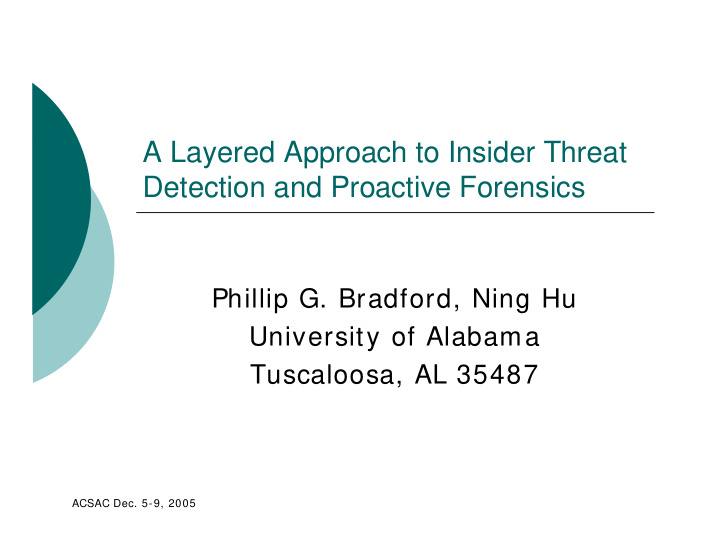



A Layered Approach to Insider Threat Detection and Proactive Forensics Phillip G. Bradford, Ning Hu University of Alabama Tuscaloosa, AL 35487 ACSAC Dec. 5-9, 2005
Insider threats Definition Menaces to computer security as a result of unauthorized system misuses by users of an organization. Insider threats are potentially more destructive than external ones: Knowledge about the target Easy access to the target Consequences for targeted organizations: Financial losses Denial of service Reputation damage Individual victims ACSAC Dec. 5-9, 2005
IDS deficiencies Given the prevalence and destruction of insider sabotages, early detection and documentation of such threats is vital to the stakeholder’s interest. The IDS alone does not offer a satisfactory solution: Detection accuracy SID is known for false negatives. AID is prone to false positives. Costs Lee et. al .’s classification: [ 5] damage, response and operational costs It is an art to balance between detection cost and accuracy. Applicability Intrusion vs. extrusion Insiders may often enjoy advantages. ACSAC Dec. 5-9, 2005
Proactive forensics Imperfect proactive security Need to collect and retain important evidence that for further investigation and legal actions Proactive forensics A way to augment insider threat detection with a mixture of ID and CF tools & techniques. Definition: PF is a process of “the design, construction and configuring of (computer) systems to make them most amenable to digital forensics in the future.” [ 6] ACSAC Dec. 5-9, 2005
Objectives An effective model that monitors user activities persistently to identify potential insider threats in a timely, precise, and efficient manner. The target system performs: Online monitoring of user activities to detect potential system misuses and abuses Proactive collection and analysis of important evidence concerning insider threats Currently concerned with monitoring general user processes Non-critical and incremental threats Low-and-slow deviations ACSAC Dec. 5-9, 2005
Approaches Use the IDS as a black box to drive forensic tools The coarse-grained output of the IDS can be input to an appropriate forensic tool set (e.g. TCT) for further analysis. Build statistical metrics for fleshing out long term changes in user behavior Li et. al. [ 7] provides a theoretical model for intrusion detection Feature vector: observables Three feature ranges: { suspicious} = { normal} ∩ { anomalous} . Feature vectors are gradually aggregated into one of the three ranges. How to select the appropriate features? Use GAs to select the relevant features ACSAC Dec. 5-9, 2005
A layered architecture of our model We propose a layered architecture in implementing a Proactive Process Monitor (PPM). The current design contains three layers: The top layer quickly spots unauthorized user processes by process name with minimal overhead. The middle layer utilizes a GA-generated rule base to capture the unauthorized processes associated with particular user roles with reasonable overhead. The bottom layer performs statistical analysis over the remaining processes for any “low-and-slow” deviations from the expected process patterns associated with user roles. Suspicious or resource-draining processes from the above three layers are logged securely at a separate site for offline analysis by forensic tools. ACSAC Dec. 5-9, 2005
ACSAC 05
The small-user-world principle [6] Users in same job functions are expected to perform similar authorized actions on an organization’s computer systems. User roles can be mapped to user actions, which can be turned into observables for the detector. The recurrence of deviations as observed in users’ actions (e.g. processes) may trigger an alarm in the detector. ACSAC Dec. 5-9, 2005
Further research Completing our work on mappings from user roles to actions in line with organization-specific computer security policies: Role-Based Access Control (RBAC [ 9] ) Improving the statistical approach: Refine process metrics Avoid indiscrim inate system call tracing for cost concerns Validating our approach with experiments: Lacking good test data for insider threat detection Budget, time and legal constraints for using human subjects Simulation? ACSAC Dec. 5-9, 2005
References R. Brackney, R. Anderson, “Understanding the Insider Threat,” Proc. of 1. an ARDA Workshop, March 2004, Rockville, MD. M. Keeney, E. Kowalski, D. Cappelli, A. Moore, T. Shimeall, and S. 2. Rogers, “Insider Threat Study: Computer System Sabotage in Critical Infrastructure Sectors,” May 2005. W. Lee, W. Fan, M. Miller, S. Stolfo, and E. Zadok, “Toward Cost- 3. Sensitive Modeling for Intrusion Detection and Response,” Journal of Computer Security, Vol. 10, Numbers 1,2, 2002. D. Farmer, and W. Venema, The Coroner’s Toolkit (TCT), 2004, 4. http: / / www.porcupine.org/ tct.html D. Farmer and W. Venema, Forensic Discovery, Pearson Education, Inc., 5. 2005. P. G. Bradford, M. Brown, J. Perdue, and B. Self, “Towards Proactive 6. Computer-System Forensics,” Proc. of International Conference on Information Technology: Coding and Computing, Vol. 2, 2004 (ITCC 2004), 648-652. Z. Li, A. Das, and J. Zhou, “Theoretical Basis for Intrusion Detection,” 7. Proc. of 6th IEEE Information Assurance Workshop (IAW), June 15-17, 2005, West Point, NY. B. Shargel, E. Bonabeau, J. Budynek, D. Buchsbaum, and P. Gaudiano, 8. “An Evolutionary, Agent-Based Model to Aid in Computer Intrusion Detection and Prevention,” Proc. of the 10th International Command and Control D. Ferraiolo and R. Kuhn, “Role-Based Access Controls,” Proc. of the 15th 9. National Computer Security Conference, Oct. 1992, 554-563.d A. Wald, Sequential Analysis, New York: Wiley and Sons, 1947. 10. ACSAC Dec. 5-9, 2005
Recommend
More recommend